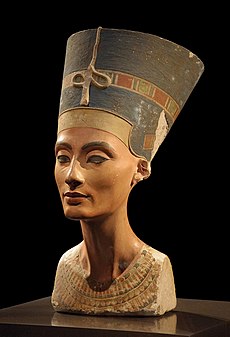Hi, it's me. Hannah (@handiangel). Haven't been around much recently. Being a final year at university is a real time sink... but I've come to grace you with my presence once more with a real life book review! ;)
 |
| The face that started a thousand legends. |
I finished the book Nerfertiti by Michelle Moran a few days ago. It is the story of the rise of Nefertiti, chief wife and queen to the Pharaoh Amunhotep IV, of the 18th dynasty. Nefertiti is, of course, quite famous. Considered one of the most beautiful women to have ever lived. Her life captured the world's imagination when her bust was found and displayed at the Ägyptisches Museum, Berlin.
The story, however is told from the perspective of Mutnodjmet, Nefertiti's younger half sister and closest ally/friend/confidante/etc.
After some judicious Wikipediaing as I went along, it becomes apparent that this era was quite a turbulent time, with religious reform and a petulant, unstable monarch on the throne.
You know what? This is starting to sound very familiar to another book I read. You've probably heard of it, read it even: The Other Boleyn Girl by Philipa Gregory.
Let's see...
- Famous historical female figure at the centre. Check.
- Central character has ambitions to get to the top. Check.
- Story told from sister's perspective. Check.
- Religious reform. Check.
- Ambitions of a family riding on central character. Check.
- Jealousy. Check
- A rise and a fall. Check.
Ok, so it sounds like the story of this book is cut and dried. Well, it's not. And I haven't just spoilt it for you either. I imagine that this story can be told a thousand times over through out the world's history. Power struggles are rife, especially in royal courts. And the Egyptian courts of the Pharaohs are no different.
 |
| The god Horus, and Nefertiti |
Unlike when I read The Other Boleyn Girl, I knew very little about the history surrounding the story I was about to read. I knew from the very beginning of The Other Boleyn Girl that is was not going to end particularly well, but in Nefertiti, I had no idea. So, Moran's world building and context setting was perhaps more important this time around, and I have to say it was very well done. You can see the surrounding dusty dessert, and the lush banks of the Nile; the ginormous limestone temples and palaces, as well as the colourful mosaics and murals that line them. It also reminds you again and again throughout what an advanced society the Ancient Egyptians were. They had toilets! I know. Impressive, right?
The actual story also flows along at a steady pace, constructing the characters in a well-rounded way. Nefertiti herself is a strong character. Ambitious, selfish, petty, beautiful. I suppose some of the side characters were a bit 2D, but it didn't hurt anything overall. The pace was quick enough to hook me in, which I really need to keep me going in a book (easily distracted). About two thirds of the way through, the pace really picks up, and I raced through the end.
I definitely enjoyed this book. I would recommend it, if only for the historical setting which is fascinating (though I imagine should be taken with a pinch of salt...). There is a sequel of sorts, that I will probably read at some point, called The Heretic Queen. So maybe there'll be a review for that at some point...


No comments:
Post a Comment